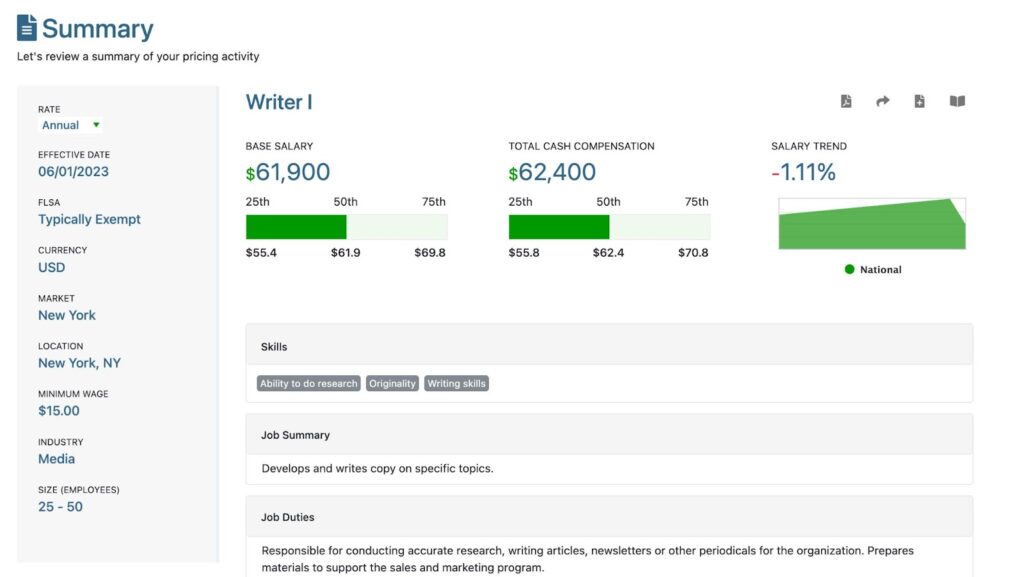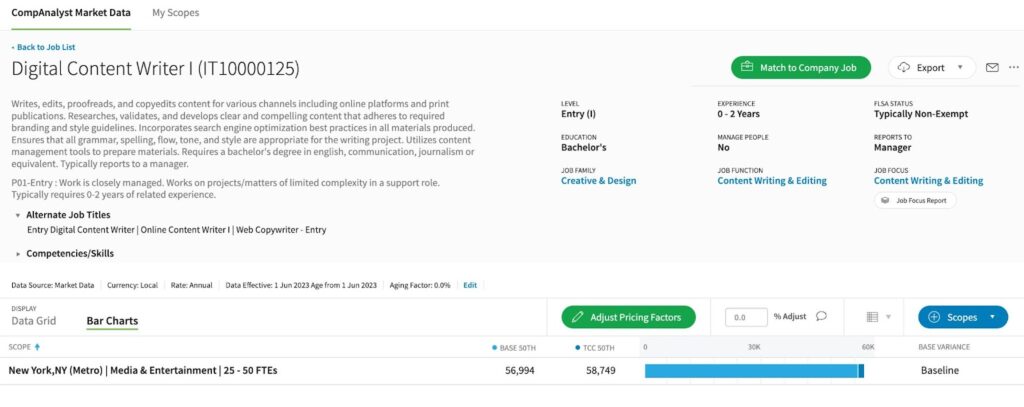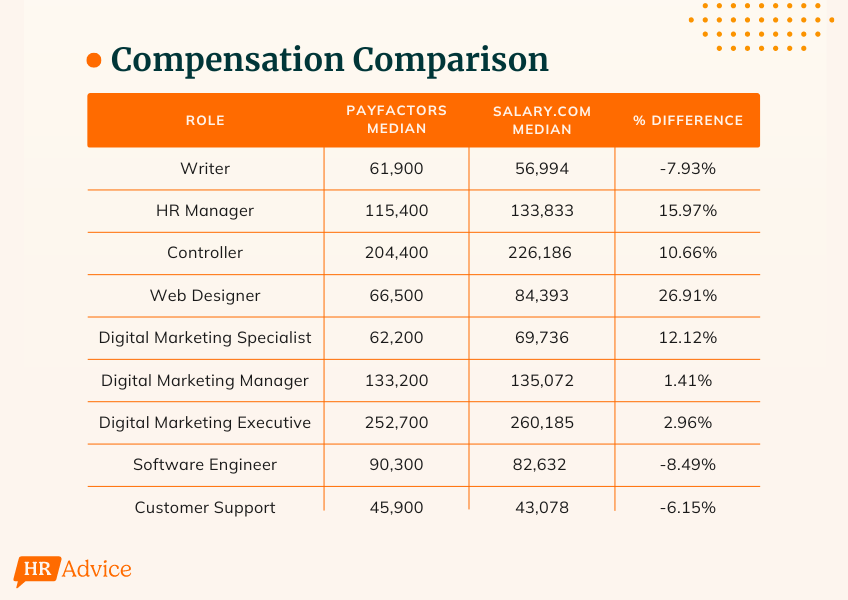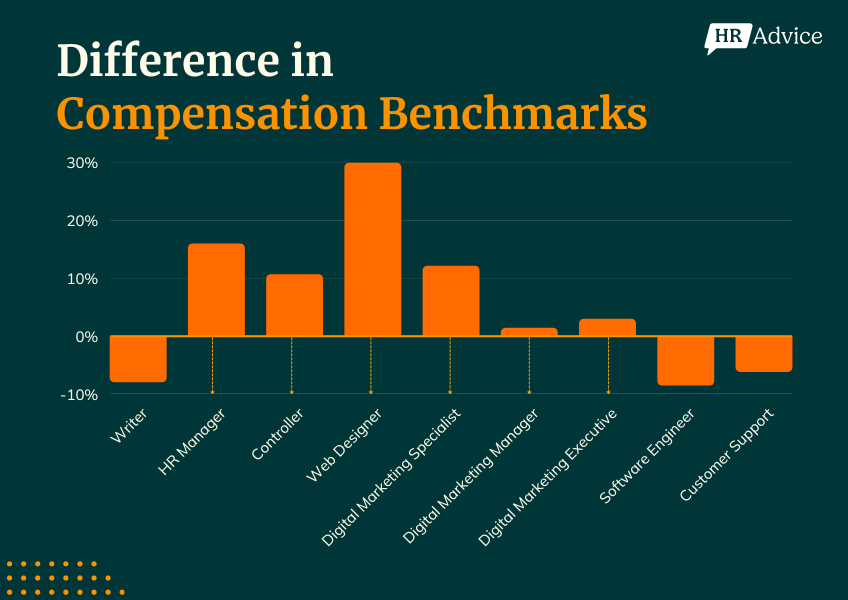We’re told compensation benchmarking will solve one of the biggest problems in every business: paying people fairly while keeping the overall costs under control.
And we’ve all heard the rules at this point:
- If we pay above average, we’ll recruit and keep great people. These folks are easily 2-3 times as productive as an average employee. I’ve definitely seen this myself.
- But we can’t pay too much. Not only will it balloon costs and put the business at risk, increased pay doesn’t impact productivity beyond a certain point. After all, it’s a hygiene factor. It’ll push people away when too low but won’t improve results once it’s high enough.
It’s a goldilocks problem. Too low, the business suffers. Too high, the business also suffers.
Compensation benchmarking solves this problem.
We take our roles, benchmark compensation to market, and make sure we’re hitting that sweet spot. An entire industry has blossomed to help managers and owners do exactly that. Pay them a fee, get access to their salary data, and get real benchmarks for all your roles. With a few clicks, you can compare your own salaries to real payroll data from thousands of other companies.
You won’t have to worry if you’re paying too little or too much ever again.
That’s the dream anyway.
We recently decided to do a round of compensation benchmarking for our own company even though we only have about 15 employees. I was an executive at other companies that waited way too long to do their first round. It was not fun. Some folks had wildly different compensation, others were being paid way beyond any feasible benchmark, and there were a bunch of tough conversations to get everything cleaned up. I would very much like to avoid doing that again.
We actually decided to sign up for the two most popular benchmarking tools to really understand how all this works.
What we learned was disappointing. But extremely valuable.
Before we jump into our research, let’s go through the basics of compensation benchmarking.
What Is Compensation Benchmarking?
Compensation benchmarking is the process of comparing your current salaries with market data on compensation. That way you’ll know if you’re overpaying or underpaying for your roles. Companies will usually pay for a benchmarking tool in order to get access to real HR-reported data, then compare their roles to get benchmarks.
You usually follow this process when doing compensation benchmarking:
- Job description cleanup: Most JDs are a mess at companies but you’ll need accurate scopes of each role in order to benchmark them correctly. The more work done here, the easier everything else will be.
- Decide on a compensation philosophy: Do you want to pay below market, at market, or above market?
- Pick a benchmarking tool: The two popular tools are Salary.com and Payfactors. Almost everyone starts with one of these.
- Match your roles in your benchmarking tool: Fairly straight forward for standard roles. Non-standard or blended roles will have a lot of judgment calls that you need to make.
- Decide salary ranges: Using your compensation philosophy, you’ll pick starting and ending salary ranges for each role.
- Fix salary problems: If this is the first time you’ve benchmarked compensation or it’s been awhile, there will be some problems that need fixing. Folks making too little, others making too much. That sort of thing. You’ll have to come up with a plan on how to address each.
- Rollout salary ranges: By sharing the ranges internally, you’ll set expectations on compensation potential, get everyone aligned, and avoid major comp problems down the road.
Is Compensation Benchmarking Data Accurate?
After jumping on a bunch of demos with all the leading benchmarking tools, we made a crazy decision.
What if we signed up for multiple tools, got access to multiple data sets, and compared them?
That’s exactly what we did, we signed up for Salary.com and Payfactors.
When I started this process, I figured that standard roles would all be roughly the same. Maybe off a bit but close enough to not worry about it.
I was wrong.
Let’s take a standardized role: a writer for an online media company. We’ll base it in New York, New York for a company with 25-50 employees. We’ll also use HR reported data which should have less noise and be more reliable.
Here’s the data from Payfactors:

Base median pay of $61,900, that tracks with my experience.
Now let’s look at Salary.com:

Base median pay of $56,994. Roughly a decrease of 8% from the Payfactors data. That’s not a trivial amount for folks.
Telling someone that they could make about 10% less just because your company picked a different compensation benchmarking tool won’t lead to happy and fuzzy feelings.
Another way to look at it: tell someone they could make $5K less just because you signed up for a different data set. Not great.
Alright, this is just one role.
What about others? What if I matched the roles poorly? What if this is an anomaly?
Here’s the media salary data we found across a range of roles:

What we did to keep this data as clean as possible:
- Picked roles that we have experience with. Every tool calls their roles something different. We wanted to make sure we were matching the substance of roles and not just titles. Since we picked roles we had experience with, we were able to catch these differences and match on role substance.
- Used a specific, single market. For every role, we looked up salary info for a company with 25-50 employees, in New York City, in the media industry.
- Used roles at the start of their bands or at clear management tiers. Senior IC (independent contributor) roles and senior bands can always get funky, everyone has different standards. But there should be less noise at entry level IC roles, first level manager roles, and well-known executive roles.
- Looked at base compensation. Total cash compensation varies widely across organizations so we only looked at base compensation to get a more reliable comparison.
- Only used HR-reported data. Some tools have employee-reported data or scrape compensation from online sources. We didn’t use those data sets at all, we only compared HR-reported data across tools.
- Pulled all data on the same date. These data sets do update monthly so all data was pulled on the same date to avoid any noise here.
What stands out to me is how the percentage difference is all over the place:

What I take away from this data:
- While Salary.com tends to skew higher, it’s not a consistent trend. So we can’t simply use Payfactors, hedge 10% higher, and call it a day.
- Oddly enough, some of the management roles were the most consistent, I would have expected it to be the opposite. No idea if this is luck or a consistent trend, we’d have to compare a lot more roles. But we can’t use the simple rule of “standard IC roles work, be careful with management roles.” Some of the IC roles had the most variance.
Overall, base salary medians will fluctuate by 5-10% depending on the tool that you choose. Even when you’re careful to always use HR reported data and keep the hiring market consistent.
If a tool like Payfactors was always a bit higher, I’d simply choose the tool that skewed towards higher comp and then call it a day. But since the variance isn’t consistently in one direction, you’re basically flipping a coin with each role.
Real Guidelines for Compensation Benchmarking
Should we just throw out all compensation benchmarking and skip it all together?
I don’t think so.
But I am way more skeptical of benchmarking data than I have been in the past.
I think the key is understanding what benchmarking can do and what it can’t do.
We use these guidelines ourselves.
Salary Benchmarking Gives You Rough Benchmarks, Not Precise Benchmarks
This is the tough news. And the dirty secret of HR processes around compensation.
Everyone in this industry will tell you that they can give you super precise salary data, updated monthly.
That’s all nonsense.
If you want to know if you should hire a designer for $75,000 or $77,000, benchmarking surveys can’t tell you.
They’ll certainly pretend to give you an answer but that answer has a lot of noise baked in.
But if you want to understand if you should pay $50,000 or $80,000, they can help.
When you have lots of experience with a specific role, you’ll already have a rough sense for what the market wants for comp. That sense will be pretty accurate and benchmarking tools won’t tell you something that you don’t already know.
Oddly enough, the standard benchmarking tools are probably best for smaller teams. Or teams expanding into new areas.
I remember what it was like as a first-time higher manager and my VP asked me what salary range I thought we should use for a role I needed to open. I had no idea. $50K? $90K? $120K?
It all sounded plausible to me.
Benchmarking would have saved me a ton of time, probably would have helped me close some of those candidates too.
But once you have experience with a role, compensation benchmarking won’t tell you something you don’t already know. It’s just a form of quick validation.
Expect Salary Benchmarks to be Off by 10% in Either Direction
I’d be pretty surprised if other companies signed up for multiple benchmarking tools to compare data like we did.
Most likely, you’ll have one tool with one salary median for each role.
How do you know if it’s lower or higher than other tools?
You don’t.
If you’re pulling compensation data, I’d assume that the real market median could be 10% higher or lower than whatever number you’ve been given.
My stance is to get the median, round up, then adjust based on your compensation philosophy. That gets you in the right area.
The Real Value Comes From the Illusion of Precision
I feel bad about this one but it’s true.
When a company runs a benchmarking process, gets comp ranges for all their roles, then rolls them out while pointing to the survey data, it’s extremely difficult for anyone at the company to argue against the data.
After all, the data was carefully collected, curated, and cleaned by huge teams of people. And it came from real payroll data! How could we not trust it?
It puts a hard stop to all the arguments about compensation.
The data FEELS real. It FEELS precise. It FEELs authoritative.
And everyone accepts it.
I totally understand why HR teams use it, they can point to some third party as the bad guy.
“We’re not setting the compensation at a level that’s too low, the salary benchmarks say this is the median so we have to go with it.”
It also cuts through all the management debates on what comp should be when opening roles. No more arguments about that extra $5K. I’ve had too many of these myself.
Instead of going in circles and everyone getting mad at each other, HR can pull the compensation data, grab the agreed upon percentile benchmark, and that’s it. No more arguing. This alone is probably worth the cost of the tools.
Is Compensation Benchmarking Still Worth It?
I believe so.
Having compensation ranges that all go through the same process is extremely valuable for a company. You’ll dodge so many long-term headaches by doing this.
I would acknowledge the limits of benchmarking: it won’t give you the exact salary that you should use. Expect the data to be off by 5-10% in either direction.
But it is a great source to gut check your assumptions. Or to get a rough starting point when you’re not sure.




